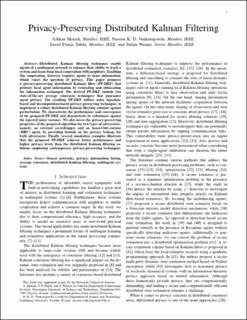| dc.contributor.author | Moradi, Ashkan | |
| dc.contributor.author | Dasanadoddi Venkategowda, Naveen Kumar | |
| dc.contributor.author | Talebi, Sayedpouria | |
| dc.contributor.author | Werner, Stefan | |
| dc.date.accessioned | 2022-12-29T13:26:35Z | |
| dc.date.available | 2022-12-29T13:26:35Z | |
| dc.date.created | 2022-07-02T13:56:28Z | |
| dc.date.issued | 2022 | |
| dc.identifier.citation | IEEE Transactions on Signal Processing. 2022, 70 3074-3089. | en_US |
| dc.identifier.issn | 1053-587X | |
| dc.identifier.uri | https://hdl.handle.net/11250/3039905 | |
| dc.description | Distributed Kalman filtering techniques enable agents of a multiagent network to enhance their ability to track a system and learn from local cooperation with neighbors. Enabling this cooperation, however, requires agents to share information, which raises the question of privacy. This paper proposes a privacy-preserving distributed Kalman filter (PP-DKF) that protects local information of agents by restricting and obfuscating the information exchanged. The derived PP-DKF embeds two state-of-the-art average consensus techniques that guarantee agent privacy. The resulting PP-DKF utilizes noise injection-based and decomposition-based privacy-preserving techniques to implement a robust distributed Kalman filtering solution against perturbation. We characterize the performance and convergence of the proposed PP-DKF and demonstrate its robustness against the injected noise variance. We also assess the privacy-preserving properties of the proposed algorithm for two types of adversaries, namely, an external eavesdropper and an honest-but-curious (HBC) agent, by providing bounds on the privacy leakage for both adversaries. Finally, several simulation examples illustrate that the proposed PP-DKF achieves better performance and higher privacy levels than the distributed Kalman filtering solutions employing contemporary privacy-preserving techniques. | en_US |
| dc.language.iso | eng | en_US |
| dc.publisher | IEEE | en_US |
| dc.title | Privacy-preserving distributed Kalman filtering | en_US |
| dc.title.alternative | Privacy-preserving distributed Kalman filtering | en_US |
| dc.type | Journal article | en_US |
| dc.type | Peer reviewed | en_US |
| dc.description.version | acceptedVersion | en_US |
| dc.rights.holder | © 2022 IEEE. Personal use of this material is permitted. Permission from IEEE must be obtained for all other uses, in any current or future media, including reprinting/republishing this material for advertising or promotional purposes, creating new collective works, for resale or redistribution to servers or lists, or reuse of any copyrighted component of this work in other works | en_US |
| dc.source.pagenumber | 3074-3089 | en_US |
| dc.source.volume | 70 | en_US |
| dc.source.journal | IEEE Transactions on Signal Processing | en_US |
| dc.identifier.doi | 10.1109/TSP.2022.3182590 | |
| dc.identifier.cristin | 2036859 | |
| dc.relation.project | Norges forskningsråd: 274717 | en_US |
| dc.relation.project | Norges forskningsråd: 300102 | en_US |
| cristin.ispublished | true | |
| cristin.fulltext | postprint | |
| cristin.qualitycode | 2 | |
